AOPA Action
What AOPA is doing to keep you flying
Suggested flight training improvement strategies reviewed
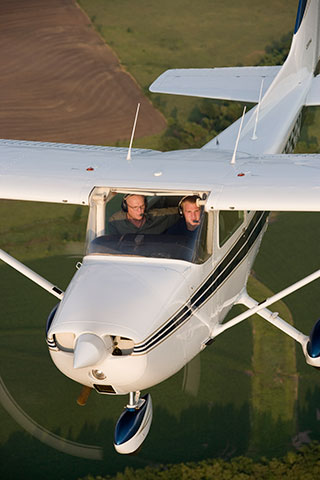 An aviation industry educational task force with the goal of reforming flight training has moved into a new phase of its work, with AOPA submitting responses to six recommendations issued in the project’s preliminary report.
An aviation industry educational task force with the goal of reforming flight training has moved into a new phase of its work, with AOPA submitting responses to six recommendations issued in the project’s preliminary report.
AOPA presented comments to recommendations that emerged from the 2011 Pilot Training Reform Symposium, hosted by the Society of Aviation and Flight Educators (SAFE). AOPA served as a sponsor of the event.
In response to the recommendations, AOPA discussed initiatives already in progress. One example of such an initiative includes a general aviation accident root cause analysis currently under way under the General Aviation Joint Steering Committee (GA JSC). AOPA currently serves as co-chair of the GA JSC and participates in the subcommittees directly involved in the analysis. This initiative will guide future risk mitigation strategies in GA operations and flight training.
Other initiatives currently under way are the AOPA Flight Training Student Retention Initiative, which launched in June 2010, and a knowledge test advisory committee that will work to develop
a process to write and revise current knowledge exams with input from
the flight training industry and experts in flight training.
Other recommendations within the SAFE preliminary report show promise yet need to be further developed before action is taken.
NATIONAL
Group to advise on airmen testing
FAA Administrator Randy Babbitt has announced that the FAA is launching an initiative to review the agency’s process of developing airmen knowledge testing material.
Unexpected changes to knowledge tests earlier this year suddenly and dramatically increased failure rates for those tests. Concerned that the FAA had changed the tests without providing training material explaining learning objectives to test-takers, AOPA and other industry groups met with the FAA’s airmen testing and standards branch to discuss the agency’s approach to test-question validation.
After a follow-up meeting with AOPA, the National Association of Flight Instructors (NAFI), and experts in test writing and validation, the FAA announced it would remove certain questions from the Fundamentals of Instruction test and regrade tests; and now a new initiative will review the process by which the FAA develops new testing material, updates current questions, incorporates input from industry, and validates questions prior to changes in the existing test banks.
AOPA, NAFI, and other flight-training experts advocated for the creation of the committee to ensure that knowledge tests are a valid and reliable measure of knowledge. The two associations, along with experts in academia from Embry-Riddle Aeronautical University, Liberty University, the Professional Board of Aviation Certification, the University of North Dakota, the University of Oklahoma, and the University of Western Michigan, met to discuss failures in the knowledge exams and determined that the dramatic increase in failure rates was caused, in part, by the methods used to write and validate questions. The groups recommended revising or removing certain questions from exams and discussed industry-accepted methods for developing and validating exam questions.
FAA fixes turbojet proficiency compliance deadline
The FAA has amended a recent rulemaking, which set a requirement for pilots of turbojet-powered aircraft to undergo a pilot-in-command proficiency check, to give affected pilots a year from the effective date to take the initial required checkride.
The final rule, which took effect October 31, 2011, gives pilots of single-pilot turbojet-powered aircraft and, with some exceptions, turbojet-powered experimental aircraft, until October 31, 2012, to meet the new initial requirement under FAR 61.58.
AOPA’s government affairs staff advocated for the time provided for in the technical change. Allowing additional time was necessary because flight training providers are unable to give the new proficiency checks without first having the procedure added to their training manuals. Additionally, simulator time is typically scheduled weeks or months in advance, making it nearly impossible for pilots to compliy with the original date.
“Without this additional time, operators of these aircraft could have been grounded until the training providers got FAA approval,” said Kristine Hartzell, AOPA manager of regulatory affairs. “The FAA’s quick response to the industry’s concerns avoided that.”
STATE AND LOCAL ACTION

The number of co-sponsors—both Democrats and Republicans—of House Bill 1100.

The percentage of airframe and powerplant (A&P) mechanic students who remain in Pennsylvania after graduation.

The amount of new state taxes on general aviation signed into law this year. AOPA fought tax increase proposals in several state legislatures this year—and won in Washington, Connecticut, and Massachusetts.
1 Pennsylvania: Pennsylvania aircraft tax exemption clears committee
A Pennsylvania bill to exempt aircraft sales, parts, and labor from a 6-percent tax moved forward, when the House Committee on Finance voted 18-6 to recommend passage. House Bill 1100, which applies to fixed-wing aircraft, was introduced by Rep. Peter J. Daley (D-Donora), who was joined in supporting the measure by about 60 cosponsors. The bill’s backers urged passage to boost the state’s economy, create quality job opportunities in the aviation industry, and maintain competitiveness with other northeastern states that have adopted tax reforms.“This is about jobs—from pilots to computer technicians, attendants and skilled aviation mechanics to maintain aircraft, to making Pennsylvania a competitive place to start or relocate a company that relies on aircraft in our global marketplace,” Daley said after the committee vote. “When a similar measure was passed for helicopters, a company in West Chester added 412 jobs,” he said. No date has yet been set for action by the full House. Supporters pressed home in recent testimony the point that Pennsylvania found itself at a competitive disadvantage following action by other northeastern states to create a friendlier business climate for aviation. Connecticut and Massachusetts, both with far fewer airports than Pennsylvania, “have significantly more aircraft mechanics currently working in the state, for good, livable wages,” said Mark Kimberling, AOPA director
Connecticut and Massachusetts, both with far fewer airports than Pennsylvania, “have significantly more aircraft mechanics currently working in the state, for good, livable wages.”
of state government affairs, who appeared before the full committee just prior to the vote. At a an earlier field hearing on the bill at the Washington County Airport, AOPA Eastern Regional Representative Greg Winton discussed the effects of a sales tax on aviation enterprises, and how AOPA had worked with other states to remove those barriers to competition. John Graham of the Pittsburgh Institute of Aeronautics told the finance committee that only 5 percent of airframe and powerplant (A&P) mechanic students remain in Pennsylvania after graduation because of the scarcity of jobs. Bradley Penrod, manager of Pittsburgh International Airport, said that even aircraft owned by the state of Pennsylvania are sent out of state for maintenance to save on repair costs. To further stress the economic urgency of this measure, Kimberling cited the new planned Gulfstream facility in Massachusetts and recent comments from leading aviation financial analyst Heidi Wood. He pointed to a rebound in the business aviation sector in 2012, explaining that “in evaluating and voting on this bill, it is really a choice about whether Pennsylvania will lead or continue to follow other states in attracting new aviation investment and jobs to the Commonwealth—now and into the future.” —Dan Namowitz
2 Washington: Seaplanes in, mussels out at Lake Whatcom
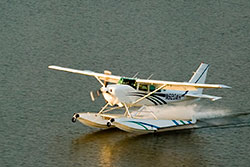 Washington state seaplane pilot Doug Tomczak can now dock his airplane at Lake Whatcom. Tomczak had received a conditional use permit to moor his seaplane at his dock on Lake Whatcom, which has a seaplane base, but the state Department of Ecology overturned the permit, claiming that the seaplane could introduce invasive species such as zebra mussels. Concerned that it could create a precedent for keeping seaplanes off of Lake Whatcom, the Washington Seaplane Pilots Association (WSPA)appealed the denial. With the help of a volunteer legal team and support from area pilots, WSPA and Tomczak reached a settlement with the Department of Ecology that both approves the permit and protects the ecology of Lake Whatcom.
Washington state seaplane pilot Doug Tomczak can now dock his airplane at Lake Whatcom. Tomczak had received a conditional use permit to moor his seaplane at his dock on Lake Whatcom, which has a seaplane base, but the state Department of Ecology overturned the permit, claiming that the seaplane could introduce invasive species such as zebra mussels. Concerned that it could create a precedent for keeping seaplanes off of Lake Whatcom, the Washington Seaplane Pilots Association (WSPA)appealed the denial. With the help of a volunteer legal team and support from area pilots, WSPA and Tomczak reached a settlement with the Department of Ecology that both approves the permit and protects the ecology of Lake Whatcom.
“This has truly been a team effort and has involved many of our members as well as outside experts and all of our board members, especially Bruce Hinds and Greg Corrado,” said WSPA President Stephen
Ratzlaff in announcing that a Washington state appeals board had approved the settlement.
Seaplane pilot and attorney Ken Berger donated his time to represent Tomczak, and the public interest legal organization Pacific Legal Foundation led representation of WSPA, Ratzlaff said.
3 Idaho: Fuller, governors discuss state fees, ADS-B
“Engaging governors is invaluable to our advocacy efforts.”—AOPA President Craig Fuller
AOPA President Craig Fuller participated in a panel of Democratic governors and private sector leaders to discuss the future of the nation’s transportation and infrastructure—and, specifically, the direction of general aviation. During the discussion, hosted by the Democratic Governor’s Association (DGA) in Charlotte, North Carolina, Fuller highlighted several pressing issues facing GA, ranging from detrimental state tax proposals to the lack of progress in establishing sufficient funding for NextGen. “Engaging governors at events like this is invaluable to our advocacy efforts,” said Fuller. “Governors not only make key decisions on taxes and the management of airports at the state level; many of these respected leaders also have a strong voice in Washington as Congress and the president make decisions on important issues like user fees and FAA funding.”
Form a support group
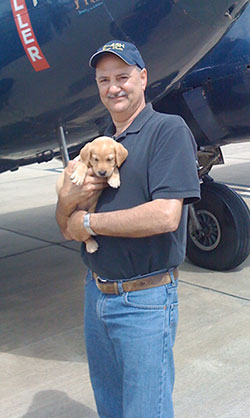 Promoting and protecting your community airport is a big job—bigger than any one person. AOPA’s Airport Support Network volunteers work hard to keep the association’s Airports staff in the know about any challenges or problems at their airports, but that’s just scratching the surface.
Promoting and protecting your community airport is a big job—bigger than any one person. AOPA’s Airport Support Network volunteers work hard to keep the association’s Airports staff in the know about any challenges or problems at their airports, but that’s just scratching the surface.
The best way to ensure your airport is both safe from problems and appreciated by the community is to form an airport support group. Bringing together a group of airport users and supporters is the best way to share the work and have fun doing it.
Archie Taylor, ASN volunteer at Fort Worth Meacham International Airport in Fort Worth, helped AOPA organize an event with area pilots to discuss this idea. Taylor and his friends at the airport did a great job hosting the event in a hangar owned by AOPA member Stan Thomas.
To help local pilots organize, AOPA has written a guide to Organizing your Airport Group. In it you will find step-by-step instructions on how to pull your entire airport community together, how to use the group to effectively tell the story of your airport to your neighbors, and how to protect the airport should problems arise.
Keep in mind there are lots of people who care about or benefit from a local airport. Reach out to the airport management, local officials and business owners to build your airport group. Remember, the airport benefits many aspects of the community—not just pilots.
For more information on learning how to volunteer for AOPA, visit AOPA Online.
AOPA MEMBERSHIP PRODUCTS
Surprising benefits of AOPA credit card
Bonus goodies come with every card
 You’ve been hearing about AOPA’s credit card for years, and you may have thought you don’t need another credit card. Sure, your use of this card earns you points quickly (one point for each dollar spent) that you can redeem for cash and merchandise. Sure, your use of this card helps AOPA and its lobbying efforts on behalf of all general aviation pilots. But to answer the basic question, “What’s in it for me?” the answer is, “Plenty!”
You’ve been hearing about AOPA’s credit card for years, and you may have thought you don’t need another credit card. Sure, your use of this card earns you points quickly (one point for each dollar spent) that you can redeem for cash and merchandise. Sure, your use of this card helps AOPA and its lobbying efforts on behalf of all general aviation pilots. But to answer the basic question, “What’s in it for me?” the answer is, “Plenty!”
You’ll get 0-percent introductory APR for the first 12 statement closing dates following the opening of your account. You can’t beat that for a low interest rate. After the first 12 months, your APR will vary according to your creditworthiness.
Some purchases net you double points. In addition to companies such as Sporty’s Pilot Shop, King Schools, and Aircraft Spruce and Specialty, many fixed-base operators offer double points as well. Buy fuel a few times at a “double-pointer” FBO, and you’re well on your way to earning cash and merchandise.
There’s no annual fee. You’ll never see a $45, $75, or $125 surprise charge on your billing statement when you least expect it, because AOPA’s World Mastercard has no annual fee.
Add all the benefits together, and it makes sense to apply today. Apply for the AOPA World MasterCard the quick and easy way, online.
A gift that keeps giving
 We’ve all received one—a gift we politely accept, then toss to the back of the closet, never to be seen again. Be it traditional, such as the ever-popular holiday sweater, or the latest gadget being pitched on TV, there are some gifts we just know will never see the light of day.
We’ve all received one—a gift we politely accept, then toss to the back of the closet, never to be seen again. Be it traditional, such as the ever-popular holiday sweater, or the latest gadget being pitched on TV, there are some gifts we just know will never see the light of day.
Luckily there is hope for gift givers and receivers alike this holiday season, and it comes in the form of the AOPA holiday ornament. Sure to add charm to any tree, the second in our line of commemorative ornaments features an aircraft that embodies the spirit of aviation, a beautiful 1940 Waco.
Not only a great gift that any aviation enthusiast would be proud to display, every purchase of the ornament made at the AOPA Online Store also benefits AOPA’s work preserving and protecting the right to fly, so it truly is a gift that keeps on giving.
Start a great new gift-giving tradition or add the AOPA holiday ornament to your holiday wish list today!
Air Safety Institute
New! Interactive map pinpoints common accidents
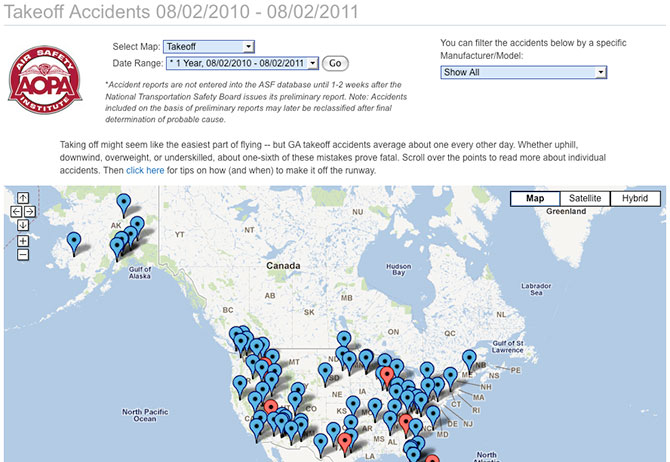
FREE AOPA ASF | |
|---|---|
| December 5 | Jacksonville, FL |
| December 5 | Mesa, AZ |
| December 6 | Daytona Beach, FL |
| December 6 | Tucson, AZ |
| December 7 | Albuquerque, NM |
| December 7 | Tampa, FL |
| December 7 | Timonium, MD |
| December 8 | Palm Beach Gardens, FL |
| These programs are made possible by gifts from individual pilot donors to the AOPA Air Safety Foundation. Seminar dates are tentative. For final dates, please visit the Web site. | |
Just one glance at the Air Safety Institute’s latest accident map shows that pilots keep getting caught by the same snags that have trapped others before them. Displayed as colorful pinpoints, these harbingers of troublesome news show locations and details of some of the most common accidents—as well as the most consistently deadly. That’s the sad and sobering truth.
ASI is committed to help pilots be safe, but your involvement is paramount to achieve success. So please, use the map to delve deeper into what happened and, more important, find out why. That knowledge may save you one day. Here’s how: Scroll over the points to read more about individual accidents, then click on a specific one to read the full report. Through this single application you can look at year-by-year patterns in takeoff, landing, fuel management, VFR-into-IMC, and stall/spin accidents. You can also switch between accident types in a single year.
Please protect yourself and your passengers and keep your flight from becoming a dot on the map.
ASI takes on winter weather worries
When cold weather and icy drizzle chill the sky, it might be a good idea to fire up the computer and hone your knowledge on the subject matter. Here are some ways to get started:
‘Weather Wise: Precipitation and Icing Online Course’
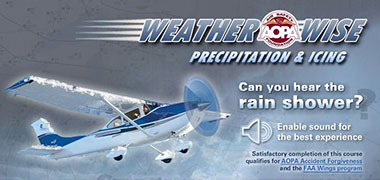 Find everything you ever wanted to know from basic weather theory to debilitating precipitation and icing phenomena—and how to stay out of it.
Find everything you ever wanted to know from basic weather theory to debilitating precipitation and icing phenomena—and how to stay out of it.
How do you detect ice and what do you do when rain turns into icy precipitation while you’re flying? What are the equipment and regulation requirements you should be aware of? You may already know why any amount of structural icing is dangerous—even a little bit—or that the top of the clouds may hold the worst icing. But, did you know that almost half of all icing-related accidents happened to pilots with more than 1,000 hours total time? Heed the warning: Experience grants no immunization when it comes to icing.
Bolster your knowledge—whether or not you fly an aircraft that is certified for flight in known icing.
‘Cold Weather Operations’ Safety Spotlight
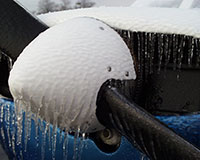 Cold temperatures, low clouds, and frozen precipitation present unique challenges during the winter season, but don’t let this discourage you. With good planning you can enjoy flying all year long.
Cold temperatures, low clouds, and frozen precipitation present unique challenges during the winter season, but don’t let this discourage you. With good planning you can enjoy flying all year long.
To warm you up, the spotlight offers a recording of ASI’s Cold Weather Ops webinar, in addition to award-winning courses, quizzes, and publications. It also includes lessons to take to heart, such as the riveting Real Pilot Story of a brand-new IFR-rated pilot, who got more than he bargained for when confronted with a winter storm over Pennsylvania mountains, and a chilling reenactment of an actual airframe icing accident.


